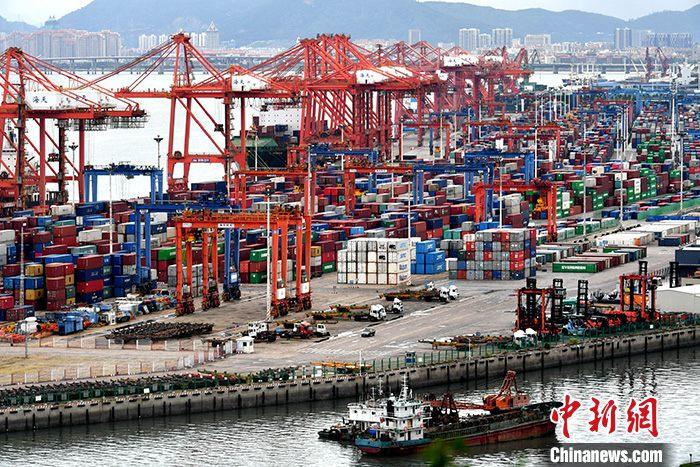(Economic Observation) Is the spring of global trade coming?
China News Service, Beijing, April 20 (Reporter Li Xiaoyu) Global trade is showing signs of speeding up improvement, but it seems that it is not time to breathe a sigh of relief.
According to the latest Japanese official statistics, exports in March increased by 16.1% year-on-year, which was the first double-digit growth in Japanese exports in more than three years; imports increased by 5.7%, which was also higher than market expectations.
Dongdu Port, Xiamen City, Fujian Province.
(Information picture) Photo by China News Agency reporter Lu Ming
In China, the total value of imports and exports in the first quarter increased by 29.2% year-on-year, far exceeding market expectations. Compared with the first quarter of 2019 before the outbreak, the growth rate was also as high as 20.5%.
In addition, due to the Spring Festival factor, China's imports and exports generally fell by double digits in the first quarter of 2016-2020, but the quarter-on-quarter decline in the first quarter of this year was the smallest in recent years.
South Korea's exports in the first quarter increased by 12.5% year-on-year, setting a new high in the same quarter of the previous year.
Among them, passenger cars, ships, wireless communication equipment, precision instruments, medicines, etc. all have an increase of more than 20%.
As of March, South Korea’s exports have increased for five consecutive months.
The latest report of the World Trade Organization (WTO) also predicts that global trade will continue to recover this year.
From the perspective of demand, due to the continuous increase of the US fiscal stimulus, the demand for North American trade in goods is expected to rise sharply in 2021, driving trade and economic growth in other regions; from the perspective of supply, the export volume of Asia is expected to increase by 8.4%, which is higher than the growth rate of Europe and the United States. .
The improvement in global trade momentum is mainly due to the acceleration of vaccination progress and the continuous recovery of major economies.
In March, the US ISM manufacturing index rose to 64.7, the highest level since December 1983; the service industry index rose to 63.7, also a record high.
The economies of the European Union and Japan are also improving.
China's economy grew by 18.3% year-on-year in the first quarter, of which consumption surged by 33.9%.
The WTO believes that if the production and distribution of vaccines progress smoothly, it is optimistic that this year can promote the global economy to increase by 1% on the basis of the forecast, and promote an additional 2.5% increase in global trade.
By the fourth quarter of this year, global trade will return to the level of normal growth before the epidemic.
However, some analysts warned that it is too early to be too optimistic about trade growth, considering that the prospects for global economic recovery are still variable.
Recently, the epidemic has repeated itself.
According to data from Johns Hopkins University, in the past week, the number of new cases worldwide in a single week increased by 12% compared with the previous week. Among them, the number of cases in India and Brazil increased sharply; the number of new deaths also increased.
Zhang Ming, deputy director of the Institute of Finance of the Chinese Academy of Social Sciences, said that the current epidemic is still spreading, and the pace and effect of large-scale vaccine promotion in developed economies and emerging markets and developing countries are significantly different.
Only when the epidemics in all countries and regions are effectively controlled can global economic growth be substantially improved.
He said that from historical experience, the negative impact of large-scale crises on the real economy and financial institutions will gradually be exposed within two to three years after the end of the crisis, and emerging economies especially need to guard against potential risks.
Therefore, the prospects for the global economic recovery this year are still highly uncertain, and may change from the currently expected V-shaped to U-shaped or "Nike"-shaped.
World Bank chief economist Reinhart also said that it will take time for the economy to return to its pre-epidemic level.
For many countries and regions, the consequences of the epidemic "will not be reversed."
According to Zhu Haibin, a China economist at JPMorgan Chase, the global economy is expected to continue to recover this year, but behind the recovery is a very serious division.
This differentiation is quite obvious within developed economies and between developing countries.
In the long run, this is not conducive to the healthy development of trade.
In addition to the uncertain prospects for economic recovery, the "black swans" flying out from time to time also disrupted the continued recovery of trade.
For example, not long ago, the Suez Canal, one of the world's shipping arteries, was blocked by a sudden ship jam, which caused hundreds of cargo ships to become impassable, and the price of containers that were already "hard to find" has increased.
As Li Xingqian, Director of the Foreign Trade Department of the Ministry of Commerce of China, said, the trend of the epidemic is uncertain, the politicization of trade issues interferes with the international trade order, the instability of the international industrial chain supply chain has increased, the international logistics capacity is tight, the freight is high, and the price of raw materials continues to rise. It is a destabilizing factor facing foreign trade in the future and "cannot be blindly optimistic."
(Finish)

